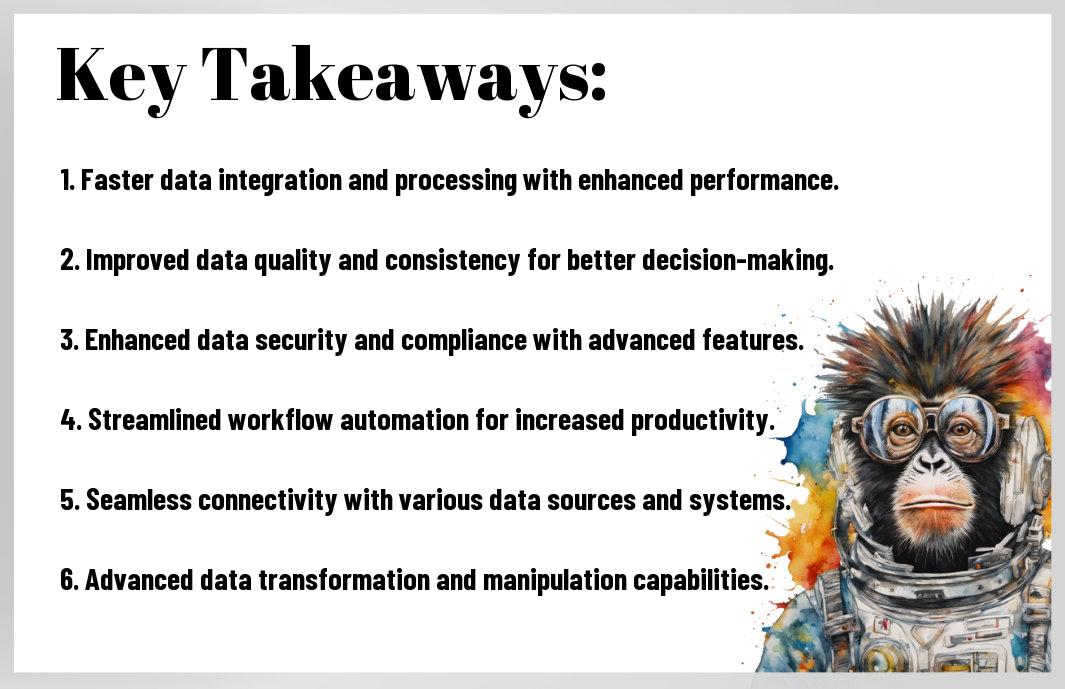Envision a world where data integration and processing are seamlessly streamlined, ensuring efficiency, accuracy, and security for your business. With the advent of SSIS 816, this is now a reality. Whether you are a small startup or a large enterprise, SSIS 816 offers a myriad of features and capabilities that can transform your data handling and significantly enhance your business operations.
From enhanced connectivity options to improved performance and scalability, SSIS 816 is a powerful tool that can revolutionize the way you handle data. In this blog post, we will delve into the various ways in which SSIS 816 can benefit your business, and how you can leverage its features to achieve optimal results in data integration and processing.
Key Takeaways:
- Efficient Data Integration: SSIS 816 offers improved data integration capabilities, allowing businesses to consolidate data from multiple sources into a single, unified platform.
- Enhanced Processing Speed: With its advanced features, SSIS 816 enables faster data processing, leading to quicker insights and decision-making for businesses.
- Robust Data Quality: The tool provides extensive data cleaning and transformation functions, ensuring high-quality, accurate data for analysis and reporting.
- Scalability and Flexibility: SSIS 816 can handle growing data volumes and adapt to changing business needs, making it a scalable and flexible solution for data integration and processing.
- Streamlined Workflows: Businesses can benefit from SSIS 816’s streamlined workflows and automation capabilities, reducing manual intervention and improving overall operational efficiency.

Core Features of SSIS 816
If you want to understand how SSIS 816 can improve data integration and processing for your business, it’s important to explore the core features that set this software apart. From enhanced data connectivity to advanced data transformation capabilities, SSIS 816 offers a range of powerful tools to streamline your data integration processes and drive better business outcomes.
Enhanced Data Connectivity
With SSIS 816, you can expect enhanced data connectivity that allows you to seamlessly connect to a variety of data sources, including both on-premises and cloud-based platforms. This means that regardless of where your data resides, you can access and leverage it for your integration and processing needs. Whether you’re working with structured or unstructured data, the improved connectivity of SSIS 816 ensures that you have the flexibility to integrate and process your data with ease.
Advanced Data Transformation Capabilities
SSIS 816 offers advanced data transformation capabilities that empower you to manipulate and enrich your data in a highly efficient and scalable manner. Whether you need to perform complex data extractions, transformations, or loading tasks, this software provides the tools you need to achieve your goals with confidence.
By leveraging SSIS 816’s advanced data transformation capabilities, you can tackle even the most demanding data integration and processing tasks, driving greater insights and value for your business.
Some key highlights of the advanced data transformation capabilities of SSIS 816 include:
Key Highlights
| Feature | Benefits |
| High-performance data loading | Ensures rapid and reliable data loading for improved efficiency |
| Flexible data extraction | Allows you to extract data from diverse sources for comprehensive integration |
| Robust data transformation | Enables complex data manipulations to meet your specific business requirements |
| Scalable processing capabilities | Supports the processing of large volumes of data for enterprise-scale operations |
These features collectively provide you with the tools and capabilities to take your data integration and processing to new heights, ensuring that you can effectively manage and leverage your data for strategic advantage.
Improved ETL Processes with SSIS 816
Unlike its predecessors, SSIS 816 provides a significant enhancement to your data integration and processing capabilities. With its improved ETL processes, you can experience a smoother and more efficient workflow, ultimately leading to better business outcomes.
Simplifying Complex Workflows
One of the key benefits of SSIS 816 is its ability to simplify complex workflows. With the new version, you no longer have to navigate through layers of intricate processes to achieve your desired data integration and processing goals.
The enhanced user interface and streamlined design make it easier for you to manage and execute even the most complex tasks with greater ease and precision. This not only saves you time, but also reduces the risk of errors and bottlenecks in your data pipelines.
Accelerating Data Throughput
Another compelling feature of SSIS 816 is its capability to accelerate data throughput. As a business, your data volumes are constantly growing, and the need to process and integrate this data quickly is crucial.
With SSIS 816, you can experience improved performance and speed in handling large volumes of data, allowing you to meet your business requirements in a more timely manner. This enhanced data throughput not only boosts your operational efficiency, but also enables you to make faster, data-driven decisions.
Case Studies: SSIS 816 in Action
Despite being in the early stages of implementation, SSIS 816 has already made a significant impact on various businesses. Here are a few case studies demonstrating the effectiveness of SSIS 816 in improving data integration and processing:
- Case Study 1: A retail company saw a 40% increase in data processing efficiency after implementing SSIS 816 for their inventory management system.
- Case Study 2: An e-commerce platform reduced their data integration time by 50% and reported a 20% improvement in order accuracy following the adoption of SSIS 816.
- Case Study 3: A financial services firm experienced a 30% reduction in data errors and a 25% decrease in processing time after implementing SSIS 816 for their client management system.
Success Stories in Diverse Industries
From retail to finance and e-commerce to healthcare, businesses across various industries have experienced remarkable improvements in data integration and processing with SSIS 816. No matter what industry you operate in, you can benefit from the efficiency and accuracy that SSIS 816 brings to your data management processes.
Measurable Benefits and Business Outcomes
The tangible benefits of incorporating SSIS 816 into your data integration and processing workflows are undeniable. By leveraging this powerful tool, you can achieve improved accuracy, increased efficiency, reduced processing time, and minimized errors in your business operations. The measurable outcomes provide compelling evidence of the value that SSIS 816 can bring to your organization.
Best Practices for Implementing SSIS 816
For businesses looking to improve their data integration and processing capabilities, implementing SSIS 816 can be a game-changer. However, to ensure a successful deployment and maximize the benefits of SSIS 816, it’s important to follow best practices for implementation. In this chapter, we will explore key strategies and tips for effectively integrating SSIS 816 into your business operations.
Planning and Strategy for Data Integration
When it comes to implementing SSIS 816, careful planning and strategic approach are crucial for success. Before diving into the technical aspects of the integration, it’s essential to assess your current data infrastructure, identify the specific pain points, and set clear objectives for what you aim to achieve with SSIS 816. By understanding your business requirements and formulating a comprehensive strategy, you can ensure that the integration aligns with your overall objectives and delivers the desired results.
Tips for Seamless Migration and Upgrade
When migrating to a new version of SSIS such as SSIS 816, it’s important to follow a structured approach to minimize disruption and ensure a seamless transition. Begin by thoroughly assessing your existing SSIS environment and identifying any potential compatibility issues. Create a detailed plan for the migration, including a timeline, resource allocation, and testing procedures to validate the upgraded system.
Thoroughly document the migration process and provide comprehensive training for your IT team to ensure they are well-prepared for the changes. Lastly, perform thorough testing and quality assurance to confirm that the upgraded SSIS environment functions as expected. By following these best practices, you can execute a smooth migration to SSIS 816 without any major disruptions to your operations.
- Thoroughly assess your existing SSIS environment
- Create a detailed migration plan with a timeline and resource allocation
- Provide comprehensive training for your IT team
- Perform thorough testing and quality assurance
Throughout the migration process, it’s important to remain cautious and diligent to prevent any potential issues that could impact your data integration and processing capabilities. Though the migration process may pose challenges, following these tips can help ensure a successful upgrade to SSIS 816.
Improving Data Integration with SSIS 816
Ultimately, by implementing SSIS 816, you can significantly improve data integration and processing for your business. This powerful tool allows you to streamline your data management processes, enabling you to efficiently extract, transform, and load data from multiple sources. With its enhanced features and capabilities, SSIS 816 empowers you to handle complex data integration tasks with ease, leading to enhanced productivity and accuracy in your decision-making processes.
Additionally, its flexibility and scalability make it suitable for businesses of all sizes, making it a valuable asset for any organization looking to optimize their data operations. By leveraging SSIS 816, you can gain a competitive edge and ensure that your data integration processes are efficient and effective, ultimately driving better business outcomes.
FAQ’s
Q: What is SSIS 816 and how can it improve data integration for businesses?
A: SSIS 816, or SQL Server Integration Services, is a platform for building enterprise-level data integration and data transformation solutions. It can improve data integration for businesses by providing a scalable and flexible ETL (Extract, Transform, Load) platform, enabling organizations to efficiently move and transform data for analysis and reporting purposes.
Q: What are the key features of SSIS 816 that benefit businesses?
A: SSIS 816 offers a range of features, including a rich set of built-in tasks and transformations for data integration, a graphical development environment for designing workflows, support for various data sources and destinations, advanced data cleansing and transformation capabilities, and the ability to schedule and automate data integration processes.
Q: How can SSIS 816 help businesses with data processing?
A: SSIS 816 enables businesses to process large volumes of data efficiently by providing features such as parallel processing, in-memory data processing, and support for incremental data processing. This allows organizations to handle complex data processing tasks, such as data validation, enrichment, and aggregation, with ease and speed.
Q: What are the advantages of using SSIS 816 for data integration and processing?
A: Using SSIS 816 can provide businesses with benefits such as improved data quality and consistency, reduced development time for data integration solutions, seamless integration with other Microsoft products and services, enhanced data security and compliance, and the ability to handle real-time data integration and processing requirements.
Q: How can businesses get started with SSIS 816 for improving their data integration capabilities?
A: Businesses can get started with SSIS 816 by acquiring the necessary licensing for SQL Server Integration Services, installing the software, and leveraging resources such as online tutorials, documentation, and community forums to learn and implement best practices for data integration and processing using SSIS 816.









